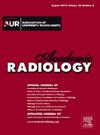Efficacy of Radiofrequency Ablation in Autonomous Functioning Thyroid Nodules: A Comprehensive Systematic Review and Meta-analysis
IF 3.8
2区 医学
Q1 RADIOLOGY, NUCLEAR MEDICINE & MEDICAL IMAGING
引用次数: 0
Abstract
Background
Radiofrequency ablation (RFA) is a minimally invasive outpatient procedure that has recently emerged as a treatment option for autonomous functioning thyroid nodules (AFTNs), offering a less invasive alternative to surgery.
The objective of this systematic review and meta-analysis is to evaluate the efficacy of RFA for AFTNs.
Method
Global databases of PubMed, Scopus, Embase, Web of Science, and Cochrane Library were systematically searched from 1990 until January 5, 2024, for studies on AFTNs undergoing RFA that presented volume reduction ratio (VRR) for at least one of 1, 3, 6 or 12 months post-operative follow-up with the results presented as means. The primary outcomes were VRR and TSH normalization rate, and the secondary outcomes were the cosmetic score, symptom score, and post-procedure complications. Heterogeneity was assessed by Cochrane and I2 statistics, and a random-effects model was used for meta-analysis. The study protocol was registered on PROSPERO (CRD42024499932).
Results
A total of 10 eligible studies with a total sample size of 254 were included. The pooled VRR after 1, 3, 6, and 12 months of follow-up post-treatment with RFA was 46.6% (95% CI: 40.3–52.9%), 62% (95% CI: 57.6–66.4%), 67.4% (95% CI:62.3–72.6%), and 77.2% (95% CI: 79.2–81.5%), respectively. The overall rate of TSH normalization was 76.4% (95% CI: 58.1–88.4%). Based on included studies the overall rate of subclinical hypothyroidism as one of the most important side effects of this method was 4% (95% CI: 1.9%−8.1%).
Conclusion
RFA emerges as a promising non-surgical treatment for AFTNs, showing high rates of TSH normalization, tumor size reduction, and improved cosmetic and symptom scores. However, further research is needed to compare RFA with surgical methods and assess long-term outcomes.
射频消融对自主功能性甲状腺结节的疗效:全面系统回顾与元分析》。
背景:射频消融术(RFA)是一种微创门诊手术,最近已成为自主功能甲状腺结节(AFTNs)的一种治疗选择,为手术提供了一种创伤较小的替代方法。本系统综述和荟萃分析旨在评估RFA治疗AFTNs的疗效:方法:系统检索了自1990年至2024年1月5日期间PubMed、Scopus、Embase、Web of Science和Cochrane Library等全球数据库中关于接受RFA治疗的AFTNs的研究,这些研究在术后1、3、6或12个月的随访中至少有一项提供了体积缩小率(VRR),结果以均值表示。主要结果为VRR和TSH正常化率,次要结果为外观评分、症状评分和术后并发症。异质性通过 Cochrane 和 I2 统计法进行评估,并采用随机效应模型进行荟萃分析。研究方案已在 PROSPERO(CRD42024499932)上注册:结果:共纳入了 10 项符合条件的研究,样本量共计 254 个。RFA治疗后随访1、3、6和12个月后的总VRR分别为46.6%(95% CI:40.3-52.9%)、62%(95% CI:57.6-66.4%)、67.4%(95% CI:62.3-72.6%)和77.2%(95% CI:79.2-81.5%)。TSH 正常化的总比率为 76.4%(95% CI:58.1-88.4%)。根据纳入的研究,亚临床甲状腺功能减退症是该方法最重要的副作用之一,其总体发生率为4%(95% CI:1.9%-8.1%):RFA是一种很有前景的非手术治疗AFTNs的方法,它能使促甲状腺激素正常化、缩小肿瘤体积、改善外观和症状评分。不过,还需要进一步研究,将 RFA 与手术方法进行比较,并评估长期疗效。
本文章由计算机程序翻译,如有差异,请以英文原文为准。
求助全文
约1分钟内获得全文
求助全文
来源期刊

Academic Radiology
医学-核医学
CiteScore
7.60
自引率
10.40%
发文量
432
审稿时长
18 days
期刊介绍:
Academic Radiology publishes original reports of clinical and laboratory investigations in diagnostic imaging, the diagnostic use of radioactive isotopes, computed tomography, positron emission tomography, magnetic resonance imaging, ultrasound, digital subtraction angiography, image-guided interventions and related techniques. It also includes brief technical reports describing original observations, techniques, and instrumental developments; state-of-the-art reports on clinical issues, new technology and other topics of current medical importance; meta-analyses; scientific studies and opinions on radiologic education; and letters to the Editor.
 求助内容:
求助内容: 应助结果提醒方式:
应助结果提醒方式:


